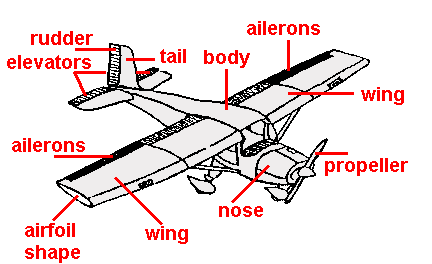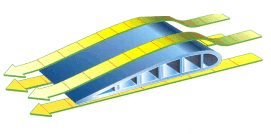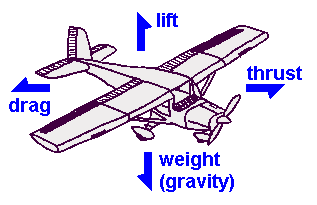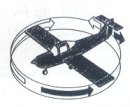

The Airplane:

| Using the above picture, try answering the questions below. To see the answers, click and drag across the blank areas. |
| A plane has a nose and a body just like people do. |
| Just like a bird, an airplane has wings, a body, and a tail. |
How the wings work: (The picture is from the McGraw Hill Technology Interactions)
 |
The wings are in the shape of an airfoil which means that the bottom side is flat and the top side is curved. The air that moves across the bottom side has a shorter distance to travel because |
| it is moving in a straight
line. The air that moves over the top is moving slower because the surface is
curved. Look closely at the yellow lines. There are less squares marked off on
the bottom side than on the top side. The air pressure is lower on the top creating
a kind of vacuum that pulls the wings upward. This is called lift. When there
is enough lift, the whole airplane is lifted up and can fly. Of course, the plane must be moving forward to make the air move. The propeller moves the airplane forward using the same concept and forces as the wings. The propeller blades are shaped like little wings and when spinning create thrust to pull the airplane forward. To review, try to fill in the blanks in the following two sentences. Remember to click and drag across the spaces to see the answers. |
|
| The special shape of an aircraft's wings creates lift as air moves across them. |
| The propeller creates thrust that moves the aircraft forward. |
Flight Forces:
An airplane flies because of the combination of the following 4 forces of nature - lift,
weight, thrust, and drag. The picture below shows the direction of the force that is
operating on the airplane.
 |
As you can see, for the airplane to fly, it must have more lift operating than weight. And, for the airplane to move forward, it must have more thrust operating than drag. |
| Lets use the math symbols of < for greater than and > for less than in the following 2 questions. (Remember to click and drag across the blank spaces to see the correct answers.) |
| To get an airplane off the ground, the airplane's lift (the air going over the wings) must be > it's weight. |
| And, the thrust (forward movement created by a propeller or jet engine) must be < than the drag created by the air movement over the wings. |
| Control Surfaces: Control surfaces change the direction of airflow, which in turn, changes the lift force - how the airplane will fly. |
There are 3 control surfaces
| Ailerons | Elevators | Rudder | |
| What do they control? | roll | pitch | yaw |
| How do you do it? | turn the yoke | push/pull the yoke | use foot petals |
| What does it do? | rolls the aircraft from side to side | moves the nose up or down | moves the nose left or right |
| What does that look like? |  |
 |
 |
Lets try some review questions
| The elevators makes the plane's nose go up or down when it is flying to get higher or lower in the air. |
| The ailerons make the plane's wings dip up or down for turning circles. |
| The rudder is on the plane's tail and it helps the plane to make flat turns to the left or the right. |